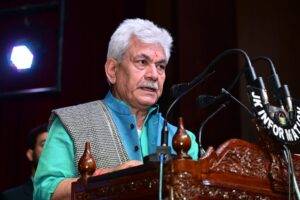The Festival of Forests will be organized by Azim Premji University in the coming month. The interns of the University got an opportunity to research and visit the forests and write about their experiences in the forest. Sharing his enriching experience, one of the interns, Devraghvendra Singh has penned down an elaborate and informative article:
A recent study revealed the Hariyali Devi forest, Uttarakhand as a model of in situ conservation of biodiversity and a prospective biodiversity heritage site. This sacred grove can be considered as one of the largest sacred groves in Uttarakhand covering an area of 5.5 sq. km.
The biodiversity and geographic relief system of the Haryali Devi forest range is exceptional and astounding. The sentinel-like mountaintop on which a temple for the Devi is located has steep slopes that descend in all directions and finally form a buffer around it. The Haryali buffer zone, which acts as a pilgrimage to the heavenly god, is bordered by more than 100 communities. It resembles a goddess-guarded stronghold and is surrounded by the Danda Khal or Dobe-2 woodland range. From the banks of the Alaknanda River, various trekking trails lead up to the entrance to the Haryali Devi forest. Any natural resource exploitation from the area’s core zone is prohibited by the region’s stringent beliefs and customs. In a symbolic way, the numerous bells strung from trees along the uphill path leading to the temple and the Holi veil offering fastened to tree trunks indicate that the area is God’s habitation and is therefore sacred. As a result, no one is allowed to cut down trees or gather fodder from the temple catchment. Every year during Diwali, local villagers organise a “Doli Yatra”. The tradition is that the whole procession of devotees (usually only men) walk barefoot during the night through the jungle, and enter the temple area exactly at a time when the first ray of sun falls on it in the morning.
During a field visit to this forest, we spoke with “Jagdish Singh Negi” who has been following these rituals since his childhood. He said, “Seven days before entering the Hariyali Devi forest we neither eat food such as garlic, onion, or meat, nor do we drink intoxicants like wine. This is done as preparation for this celebration. The people are known to have faith in Hariyali Devi and believe that she lives in all trees. As a result of this, strict rules have been imposed to protect the biodiversity of Hariyali Devi forests that host rare trees like kharso, burans, ringal and also many different types of medicinal plants, fungi and fern species. The forest is home to the black bear, leopard, flying squirrel, wild boar, and more than 100 kinds of birds, some of which are rare. Additionally, the region plays host to a wide variety of insects, some of which are endangered species like hornets and wild bees.
Hariyali Devi forest holds water resources in the form of springs, ponds, lakes, streams. Not only that, but the vegetative large carpet layer of mosses retains water, soaking it up like a sponge during wet periods and releasing it slowly in times of drought.
Hariyali Devi forest is known to promote micro plants. This forest has been preserved for a long time, due to which lichens, mushrooms and different types of micro plants have been formed here and it also shows high biodiversity.
During rainy session local community cultivate fiddle-headed fern for making some traditional vegetable, and people use it for traditional diets. Burans is the most dominant tree in this forest from March to April, and local villagers only need the flowers’ petals to make the traditional juice.
With time Haryali Devi forest or sacred grove has turned into a functional model for sustainability, nature preservation and ecological balance. Nonetheless, due to a dearth of research and literature, the site hasn’t gained the proper attention of international experts for in-depth investigations. The main literary work in the area derives from the folklore of Rudraprayag district. Hariyali Devi is a robust example of how a sacred grove can support an entire ecosystem and biodiversity through faith.
Devraghavendra is a student intern at Azim Premji University. This work was conducted as part of Forests of Life, a large climate change festival being organized by the University.
Disclaimer: The views and opinions expressed in this article are those of the author



